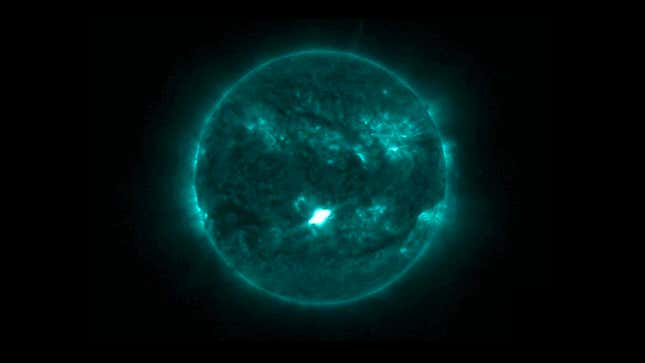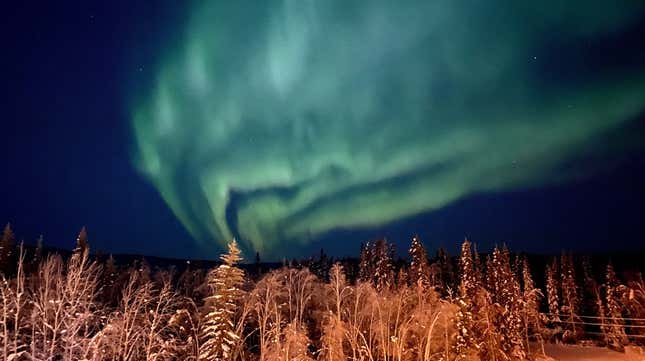Where to Spot Tonight’s Potential Magnetic Storm Aurora
A strong geomagnetic storm will hit Earth tonight following a significant solar flare that occurred on Tuesday, NOAA’s Space Weather Prediction Center reported today.
Large geomagnetic storms can cause aurorae on Earth as the radiation interacts with components of the atmosphere, causing large light shows in the sky. According to a NOAA release, the storm could generate auroras that are visible over the “upper Midwest from Illinois west to Oregon.” In other words, a sweeping northern portion of the country could be in for a real treat, depending on local weather. You can check regular updates on the aurora forecast on the Space Weather Prediction Center website.
“The aurora is not visible during daylight hours,” NOAA writes. “The aurora does not need to be directly overhead but can be observed from as much as a 1000 km [621 miles] away when the aurora is bright and if conditions are right.”
The solar flare causing tonight’s storm occurred just before 3:00 p.m. ET on November 28 in a part of the Sun called Region 3500, which is near the Sun’s central meridian. Forecasters spotted one coronal mass ejection (CME) that day and three the day before that they say are associated with the flare. The later CME is moving faster, according to the same release, as the previous CMEs cleared a path for it through the solar wind. The ejections will merge and arrive at Earth overnight, NOAA says.

Besides causing dazzling light shows, solar flares can disrupt radio communications and the power grid. In August, two large solar flares caused radio blackouts across North America. Perhaps obviously, the flares also disrupt the operations of satellites orbiting Earth.
NOAA forecasters are keeping an eye on data from the DSCOVR satellite and real time data from the solar wind to stay up-to-date on the storm’s arrival on Earth.
More: Returning SpaceX Rockets Are Creating Bright Glowing ‘Holes’ in the Sky

A strong geomagnetic storm will hit Earth tonight following a significant solar flare that occurred on Tuesday, NOAA’s Space Weather Prediction Center reported today.
Large geomagnetic storms can cause aurorae on Earth as the radiation interacts with components of the atmosphere, causing large light shows in the sky. According to a NOAA release, the storm could generate auroras that are visible over the “upper Midwest from Illinois west to Oregon.” In other words, a sweeping northern portion of the country could be in for a real treat, depending on local weather. You can check regular updates on the aurora forecast on the Space Weather Prediction Center website.
“The aurora is not visible during daylight hours,” NOAA writes. “The aurora does not need to be directly overhead but can be observed from as much as a 1000 km [621 miles] away when the aurora is bright and if conditions are right.”
The solar flare causing tonight’s storm occurred just before 3:00 p.m. ET on November 28 in a part of the Sun called Region 3500, which is near the Sun’s central meridian. Forecasters spotted one coronal mass ejection (CME) that day and three the day before that they say are associated with the flare. The later CME is moving faster, according to the same release, as the previous CMEs cleared a path for it through the solar wind. The ejections will merge and arrive at Earth overnight, NOAA says.

Besides causing dazzling light shows, solar flares can disrupt radio communications and the power grid. In August, two large solar flares caused radio blackouts across North America. Perhaps obviously, the flares also disrupt the operations of satellites orbiting Earth.
NOAA forecasters are keeping an eye on data from the DSCOVR satellite and real time data from the solar wind to stay up-to-date on the storm’s arrival on Earth.
More: Returning SpaceX Rockets Are Creating Bright Glowing ‘Holes’ in the Sky
